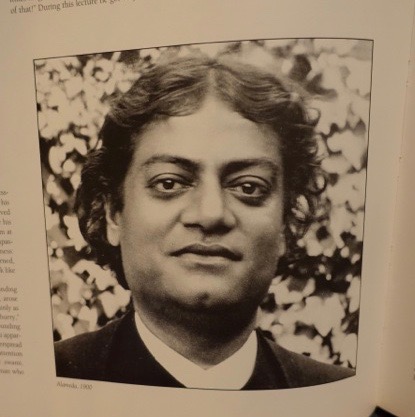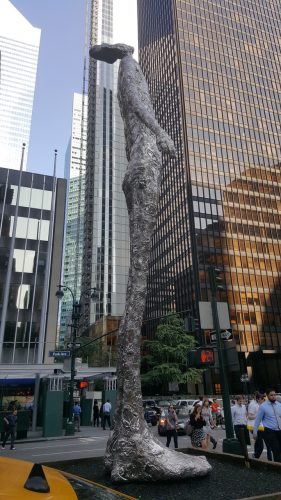Wed Dec 13th, 2017 NYC
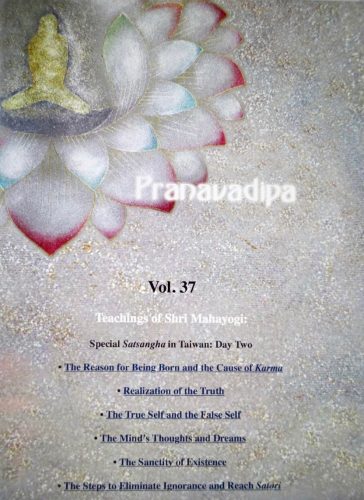
Editor’s Note: Pranavadipa Volume 37
December 8th marks the day that, after having determined single mindedly, with no other desire in his heart, to sit until he had fully realized the Truth, the Buddha awakened into Satori, the One Eternal Truth.
On this same day, in 2017, we have started a new cycle of Pranavadipa—our fourth year! As disciples living far away from our Master, it was out of our desire to stay connected, our eagerness to know and live our master’s teachings, and in feeling that his teaching is far too precious, too immense and too grand for our hearts alone to keep, that three years ago we began Pranavadipa with the hope of introducing Shri Mahayogi’s existence and his teachings to others. We hope to reach many people and also ask that you join in our efforts by supporting this work so that we can continue to make this teaching available.
Last month in Pranavadipa, Vol. 36, we had the chance to read in the Testimony some articles written by Anandi, a disciple of Shri Mahayogi in Japan. Many people mentioned how beautiful it was to read Anandi’s articles, especially the part when, upon hearing Shri Mahayogi’s advice, she apologized to her father, with whom she had had a strained relationship, for her disrespectful behavior, vowing to change herself. Indeed, it is quite a beautiful and remarkable act, but we should not remain with just the feeling that it is beautiful or remarkable, because within that act there is an important secret that we must discover for ourselves.
The other day, at the end of our class, Sadhya shared with us that although she herself had started to practice asana and meditation daily right away after meeting Shri Mahayogi, she was amazed by how straightforwardly Anandi put Shri Mahayogi’s first advice to her into action in daily life and how clear her aim must have been from the get go in order to do so!
It was from that moment of the very first meeting that Anandi put all her efforts towards acting upon the teaching that she had received from Shri Mahayogi. Whether it was due to Anandi’s sincere desire to improve something about herself and her situation, or whether it was due to what that first meeting with Shri Mahayogi kindled within her, one thing is for certain: because of Anandi’s clear aim and passion towards it, she was able to act immediately on the teaching, without question, without complaint, and as a result she was able to experience the concrete result. There is so much we can learn from that!
In Pranavadipa (Volume 37), the theme of passion towards one’s aim arises once again in the Satsangha and in the Testimony. Both are coming from Taiwan.
The Satsangha is the second of four Satsangha that took place in Taipei when Shri Mahayogi visited Taiwan for the first time in May this year, at the invitation of disciples.
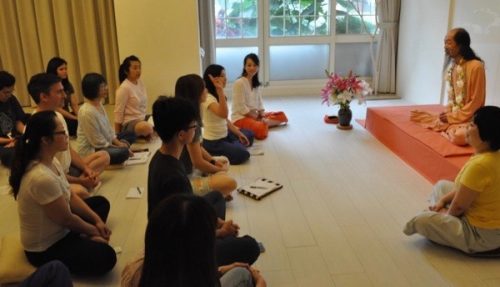
From Shri Mahayogi’s first visit to Taiwan in May 2017
Well over one hundred seekers gathered to meet Shri Mahayogi, recognizing the rareness and preciousness of this opportunity. For the majority of the attendees, this was their first opportunity to meet Shri Mahayogi, and not knowing when such an opportunity may arise again, attendees brought their earnest questions as well as a true desire to learn the teaching of the Truth and to apply the teaching practically in their lives. In their questions, the attendees gradually began to open themselves more and more to Shri Mahayogi, and as a result of their open search to resolve their heartfelt inquiries, Shri Mahayogi offers some of the most basic and foundational teachings of Yoga in a way that gives everyone the most practical tools to move forward in walking the path of Yoga.
The Testimony, which is written by Priya, is truly a testimony to her concrete experience of the efforts she has made towards putting the teaching of Yoga concretely into practice. Even though the sangha in Taiwan is relatively new in relation to sangha in Japan or in New York, the hunger for the teaching is strong and it is easy for us to feel inspired to clarify our own aim.
It is invigorating to read through the Satsangha and Testimony and feel the fresh energy that comes from the sincerity of wanting to learn and practice, indeed. The following is also a great example of this sincerity. It is an article written for the Mission’s blog in Kyoto by our new sangha member, Pan Pan, from Taiwan, right before Siri Mahayogi’s second visit to Taiwan this year.

Sangha in Taiwan in March 2017. Practicing and preparing for Shri Mahayogi’s first visit to Taiwan. (form left) Priya (in the front), Sou, Pan Pan, Marula, Mirabai (visiting from Kyoto), Tzu Yi and Radha
*
How I Felt Encountering Shri Mahayogi
In May 2017, Shri Mahayogi came to Taiwan for the first time, and four special Satsangha were held.
During the first Satsangha, as soon as Shri Mahayogi entered the room, tears began to flow out of my eyes like a broken faucet. It was not as if my mind was sad or suffering, so I didn’t know why I couldn’t stop the tears at all. I’ve never experienced anything like it before, and I still don’t know the reason for it.
On the afternoon of May the 13th, the third Satsangha was held.
Before every Satsangha, I wrote down many questions on paper. But, since the participants’ thirst for the unknown was all similar to each others’, my questions were resolved one by one through the questions and answers of others’. Shri Mahayogi answered everyone’s questions with such unwavering earnestness! He also made it clear for us, with simple answers, that there is only “That,” and that the Truth is not something that is out of reach. However, there was one question that arose in my mind…
In that moment, after Shri Mahayogi answered one of the participant’s questions, there was a pause. Then I tried to raise my hand, but Shri Mahayogi still continued to answer the previous question. I was seriously, deeply listening, so I forgot to raise my hand and others kept asking questions. But it appeared to be that no one asked the question that came to my mind, and that question kept lingering within me. After several questions and answers passed, I finally got the chance to ask my question!
When I raised my hand, Shri Mahayogi looked at me firmly. That gaze spoke to me, as if he said, “Hi Pan Pan, I know you. You have finally raised your hand. I know what you want to ask, but say it anyway.”
Pan Pan: “What is the relationship between Guru and disciple? My current understanding is that, when we are children, the teacher is always close to us. I’m sure someone like Shri Mahayogi has many disciples by his side. At the same time, many other disciples cannot be with you all the time. For those disciples that can’t be near, how can they learn?”
After hearing the translation, Shri Mahayogi nodded and said, “The Buddha, before he passed away, said the following words, ‘He who sees merely my body does not truly see me. Only he who lives my teachings truly sees me.’”
What an intense, powerful and reassuring answer! My eyes were immediately filled with tears.
Then, Shri Mahayogi explained the relationship between Guru and disciple in the following way, as a metaphor of light and darkness: “Darkness is ignorance, and in order to eradicate ignorance, light is needed. Originally, disciples are light as well, but it is hidden at the moment. When the disciple’s ignorance is removed by the help of a Guru, then true light appears. In the end, the Guru’s light and the disciple’s light become One. Because originally it was One to begin with.”
At that moment, a ray of light shone through the window from the cloudy sky. Shri Mahayogi’s body became brilliant and his face emitted light. He smiled gloriously. It was as if time stopped, and the room was filled with silence.
Shri Mahayogi continued: “Continue to learn and practice Yoga with an easy mind. I will try to make this body visible to you as much as possible.”
Upon hearing this, Shri Mahayogi, who was blurry from my tears, again appeared clearly. I nodded, was content, and cried while laughing at the same time with joy.
The answer from Shri Mahayogi became my treasure. These days when I meditate, I think of that precious, blessed time.
In another Satsangha, there was another answer that left an impression on me. One of the participants who also served as staff like me asked, “How should we see Shri Mahayogi?”
Shri Mahayogi, smiling, said, “Consider me to be yourself.”
Shri Mahayogi told us that we must practice by putting the teachings of Yoga into action. It’s been four months since then, and every time I think of these words, my mind is filled with strength and light. I began to gradually change my old life patterns. No matter how late I come home from overtime at my job, I have been trying to discipline myself to keep up with what I need to do in my daily life. For example, waking up early to make breakfast and lunch, not overeating with the amount of food, and changing my old habits; using ecological containers; practicing asana every day as much as I can (even though there are times when I’m too tired and I can’t stop yawning late at night, I still keep practicing each asana with all my might until my limit); no longer letting myself be late for work in the morning (simply so that I can earn a reward for attendance and donate it to Shri Mahayogi’s next visit to Taiwan); and training myself to not be affected by things I like or dislike at work and in life…etc. etc.
The other day I felt that lately my mind has become more at peace. When it comes to concerns about my future, I have stopped having so much fear and doubt.
I heard that Shri Mahayogi will visit again in October, which makes me very happy, so much so that I cannot contain myself. I’m so looking forward to it. I pray that even more people can meet Shri Mahayogi, and receive the strength to support themselves, just like me.
Pan Pan
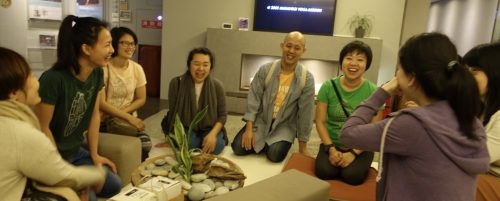
Already many staff voluntarily and willingly put forth their efforts for Shri Mahayogi’s first visit to Taiwan, even though half had not even met Shri Mahayogi yet. The sangha in Taiwan is so cheerful. There were so many smiles and laughs as they coordinated with each other out of a true sense of purpose for doing such a great service. This photo was taken after trying to create the proper space for Satsangha. Naturally a meeting formed outside the room to discuss.
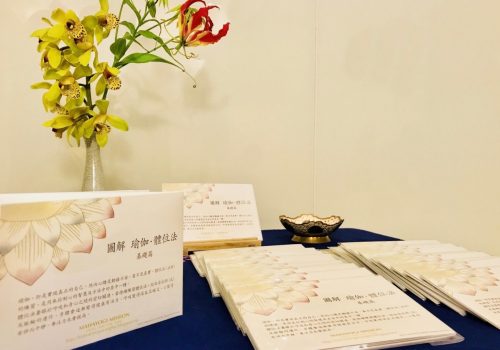
Congratulations to the Sangha in Taiwan! On December 5th, 2017, the first publications of Shri Mahayogi’s teaching in Chinese was released: Yoga Asana with Illustrations-Basic!!!
For information about the class in Taipei and publication in Chinese, please contact: http://taiwanyogasangha.blogspot.com
